BAY CITY – Bay City’s Saratoga Park was full of government officials and community members Tuesday, May 16 for the historic Upper Pool 4 Islands Complex Project groundbreaking ceremony …
This item is available in full to subscribers.
To continue reading, you will need to either log in, using the login form, below, or purchase a new subscription.
If you are a current print subscriber, you can set up a free website account and connect your subscription to it by clicking here.
Otherwise, click here to view your options for subscribing.
Please log in to continue |
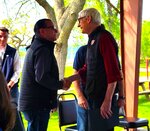

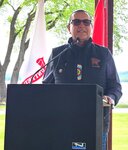
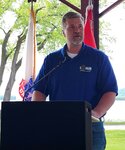

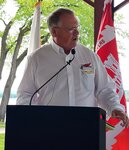

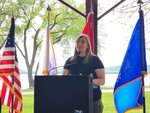
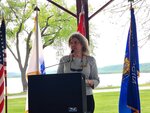

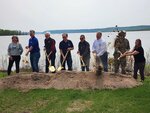
BAY CITY – Bay City’s Saratoga Park was full of government officials and community members Tuesday, May 16 for the historic Upper Pool 4 Islands Complex Project groundbreaking ceremony – a roughly $30 million project at the head of Lake Pepin meant to restore backwater habitat in the Pierce County Island Wildlife Management Area.
The state established the Pierce County Islands Wildlife Management Area to provide habitat for migratory waterfowl, water birds, fish and other wildlife, and to provide educational and recreational opportunities to the public.
The U.S. Army Corps of Engineers, along with the Wisconsin Department of Natural Resources, will construct islands (comprised of dredged material from the Mississippi River navigation channel and backwaters) at the head of Lake Pepin. The material for the islands will come from the Reads Landing Dredged Material Placement Site in Lower Pool 4 (just north of Wabasha, Minn.) Other key components will include building peninsulas, access dredging, and shoreline protection to improve fish and wildlife habitat.
Other objectives for the restoration, besides improving wetland, fish and waterfowl habitat, include increasing the health, diversity and acreage of floating and submerged vegetation; improving the health and quantity of floodplain forests; and restoring access to Bay City’s vibrant waterfront and bay.
According to the Lake Pepin Legacy Alliance, sediment buildup in Lake Pepin and the river has caused “a loss of water depth diversity in the backwater lakes and isolated wetlands above Lake Pepin and has caused reduced habitat diversity and quality, lack of aquatic vegetation and invertebrates, and reduced the number of fish and wildlife.”
Master of Ceremonies Brenda Kelly, project manager for the Wisconsin DNR, called the Mississippi North America’s greatest resource.
“We’re lucky to have her in our backyards,” she said before introducing Gov. Tony Evers. “Four main migratory birdways go through here. We must do what we can for this ecosystem.”
Evers applauded the economic and ecological impact of the multi-year, multi-million-dollar project. The Joint Finance Committee, encouraged by Rep. Warren Petryk (R-Eleva), allocated $3 million to the project, which Evers approved.
“Conserving and protecting our natural resources is part of our DNA here in Wisconsin,” Evers said. “This project will protect the long-term health of critical habitat and will serve as an example for others.”
He reminded attendees he had declared 2019 the “Year of Clean Drinking Water,” which provided funding for replacing lead pipes, remediating contaminated wells, controlling polluted runoff from agriculture and urban stormwater and clean-up for the Milwaukee and St. Louis rivers.
“Projects like this are a great example of what we can accomplish when we make work like this a priority,” Evers said.
Johnny Johnson, council president of the Prairie Island Indian Community, said the Dakota are “Born of the Water” and keepers of water in their community. The Dakota, who once owned 36 million acres, followed the buffalo and made their homes where they grazed along the river. His great-great grandfather, Chief Wabasha, had his encampment just downriver from Bay City.
“Many times our people traveled by canoe, back and forth,” Johnson said. “He was a great leader and taught us about what we need to do.”
He spoke of how the lock and dam installations flooded their villages and submerged their burial mounds. Barn Bluff (He Mni Caŋ), which towers over the river at Red Wing, is sacred to his people – it helped guide them home.
“What I’ve gone through and seen all my life … I can’t imagine what we do without our water. The Mississippi is so important to us,” Johnson said. “Everything that is in restoration of the rivers, sloughs and bays is very important to everyone, no matter where you’re from.”
Adam Payne, secretary of the Wisconsin DNR, told attendees how he grew up on the Wisconsin River. Touring the Mississippi River region put a “knot in my throat,” Payne said.
“It’s a privilege to be part of this,” Payne said. “I’m proud of the governor; $3 million was a difference maker. It took years of tremendous determination to see this through.”
The DNR and Lake Pepin Legacy Alliance, led by Executive Director Rylee Hince, co-sponsored an application to be considered for a federal pilot program that boosts funding to projects that use dredged material, In January 2019, Lake Pepin was one of 10 projects selected out of 95 nationwide for the pilot.
Roughly $4.5 million was leveraged between both states and area organizations for this project, Payne said, which will allow for maintaining a commercial navigation system integral to the country, recreation and water quality.
“Partnerships and collaboration are absolutely the key to success,” Payne said.
Bay City Village President Roger Spindler told how the Bay City Harbor was dredged in 1965 when commercial fishing was still quite active. Now, recreational fishing and waterfowl hunting are the activities of choice. The village, which is home to 500 people, couldn’t obtain enough financing to restore the harbor for which it’s named.
“The economic benefit is certainly a plus for this entire area,” Spindler said.
Col. Eric Swenson, district engineer of the Army Corps of Engineers at St. Paul, heralded the pilot program’s new way to use clean sand and dredged material to help the river.
“We are building a better tomorrow to ensure this great river continues to serve the area and the nation,” Swenson said.
Commerce on the river supplies local farmers and businesses and ensures competitive prices in global markets, Swenson pointed out. Keeping the river channel open decreases costs of material transport. Every 15-barge tow carries the same amount of freight as 1,050 semis, he added.
“Frankly, I cannot imagine 1,050 semis on the freeway,” Swenson joked. “Think of the savings to air quality, road safety and infrastructure. We are turning that sand into a new commodity that will help the environment.”
The Corps will remove up to 300,000 cubic yards of sediment from Lower Pool 4 alone. Large access channels will be dredged to Bay City Harbor during construction. Deep pools will be dug out to create habitat for overwintering fish, such as bass, crappies and bluegills. The deeper pools will also reduce wind and waves that stir up sediment from the lake bottom, so the water will be clearer.
Peninsulas will create new habitats, direct sediment downriver away from Catherine’s Pass and also reduce wind and wave action. Planted native vegetation will secure the sediment and create new habitat as well.
Hince, leader of the nonprofit LPLA for 11 years, has worked on this specific project for nine years. She highlighted key moments, such as learning in 2018 that local cost share for the project would be $4 million, or 35% (the Army Corps is providing about $20 million in funding). She was touched when local municipalities such as Red Wing, Bay City, Pepin County and Stockholm donated money from their budgets. A $750,000 grant from the Minnesota Clean Water Fund was also a gamechanger.
“Community voices represented in big projects like this just doesn’t happen very often,” Hince said.
LS Marine Inc. of Inver Grove Heights, Minn., and J.F. Brennan of La Crosse will soon begin construction. The project will take several years to complete.